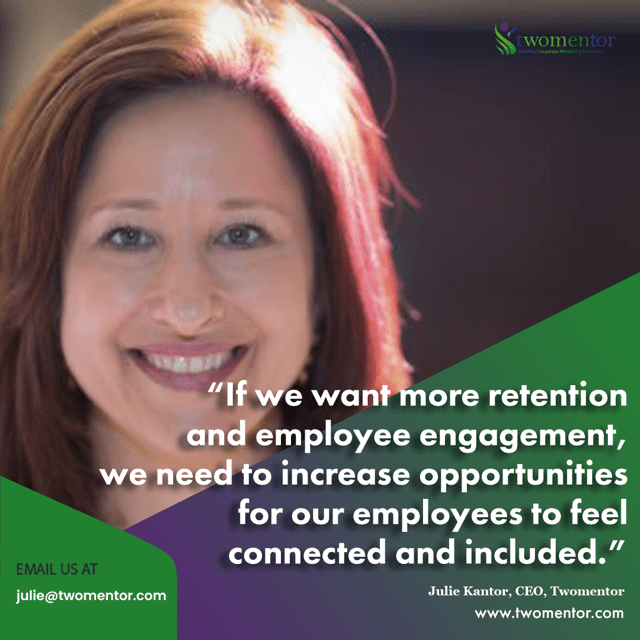Nine Ways to Prioritize Mental Health and Wellbeing in 2024
It is National Mentoring Month and we decided that we need to shine the light on mental health in the workplace. Mentoring elevates wellbeing, retention and mental health.
As we navigate the complexities of the modern world, the importance of prioritizing mental health and wellbeing has become increasingly evident. Let’s face it, we are struggling as a society and we intrinsically know (or are learning more each day) that we are not struggling alone. For many of us, and for a myriad of valid reasons, life has become a bit less comfortable and perhaps we have lost some of that proverbial spring in our step or sunny outlook.
The year 2024 brings new challenges and opportunities, making it crucial for us all to adopt practices that foster mental resilience and overall wellness. In this article, we will explore 10 effective ways to prioritize your mental health in the workplace in the year ahead.
Mindful Technology Use
I had a great discussion with a friend Marny D who is also a renowned therapist about social anxiety and staying in vs going out. We giggle at the new word we just learned JOMO (Joy of Missing Out). Our phones, YouTube, Netflix, Canasta Junction and more can replace smiling faces and festive engagements this time of year. We can a nice oxytocin boost In the digital age, technology plays a significant role in our lives. However, excessive screen time and constant connectivity can contribute to stress and anxiety (Etimes. In 2023).
#JOMO might also be showing up in the workplace in a detrimental way
Gallup’s 2023 data shows that while engagement rates stand steady at 32%, 18 percent of the workforce is now actively disengaged at work, signaling a real increase of strain on employees and their heallh and wellbeing.
Beyond mere self-care practices, 2024 issues a call to resilience, a plea for collective understanding, and a reminder that, in this challenging journey, no one need walk alone. Compassion + empathy are words that flows underneath productivity and a stellar 2024.
Unmasking the Silent Resignations
While resignations are decreasing (54 million during COVID) and layoffs have been increasing (188k in 2023), the workplace continues to witness a phenomenon known as “quiet quitting,” where even high performing employees elect to disengage and give 70% over 120%. Online platforms have been part of the challenge as I have written in previous blogs on this topic.
It’s crucial to foster an environment that encourages open communication. Employers must actively listen at Exit interviews, employee engagement surveys, provide avenues for honest dialogue, and address the root causes of dissatisfaction to rebuild a sense of purpose and connection. People managers, responsible for others, are at high risk and this all needs to be taken into consideration. Creating a culture of belonging, compassion, and helping team members find true purpose with smaller working groups.
War-Torn Minds: Healing the Unseen Wounds
In the midst of true conflict, be it on a global scale or within personal battles, the scars on mental health can run deep.
Acknowledge the trauma and encourage seeking professional help. Create safe spaces for conversations about mental health, breaking the stigma that surrounds seeking therapy or counseling. Most companies have Employee Assistance Plans (EAPs). Sharing openly the process and their value to individuals willing to share will reduce the stigma of benefitting from such services. (for example, when I utilized a therapist through EAP program a few years ago, my out of pocket expenses were under $20 a session).

Photo Courtesy of Pixabay
Navigating Political Burnout
It’s an election year. I know, those words make many cringe. The political landscape can be emotionally exhausting, contributing significantly to burnout. Encourage a workplace culture that respects diverse opinions, fostering healthy discussions while discouraging toxicity. Fear surrounds us all, regardless of party, and more and more people are opting not to even watch the news.
Provide resources for employees to stay informed without compromising their mental health, such as designated “news-free” zones during breaks. Many adopt a ‘no talk of politics’ in their ecosystems. Psychological safety is prioritized.
The Power of Collective Wellbeing
We are not suppose to suffer in silence or grieve alone. We can also find and feel joy in the darkest of times. Establish support networks within the workplace. Peer support groups, mentorship programs, and allies can create a sense of community. Employee Resource Groups should be empowered, strengthened or re-developed with leadership supports.
Knowing that others share similar struggles can alleviate feelings of isolation and promote a culture of empathy and understanding.
Articulate the ‘Not Alone’ Narrative
Develop campaigns and initiatives that emphasize the universality of mental health challenges. Share stories of resilience, recovery, and coping strategies. Let individuals know that their experiences are valid, and they are not alone in navigating the complexities of mental health.
Mindful Leadership in Times of Crisis
Leadership plays a pivotal role in shaping the mental health landscape. Equip leaders with tools for mindful decision-making and empathetic leadership (Emotional Intelligence: Key to Mindful Leadership in Australia, 2023).
Leaders who prioritize their own mental health set a powerful example and create an environment where employees feel valued and supported.
In a world filled with uncertainties, empathy becomes the glue that holds communities together.
Organizations must invest in learning and training around compassion, fostering an environment where colleagues not only understand the struggles of their peers but actively work towards creating solutions together.
Flexibility as a Form of Support
Recognize that a rigid work structure can exacerbate mental health challenges. Implement flexible work arrangements, remote options, and mental health days to empower employees to prioritize their wellbeing without fearing professional repercussions.
Break the silence surrounding mental health by fostering a culture of openness. Create platforms for employees to share their experiences, whether through anonymous forums, town hall meetings, or designated mental health awareness events (Blake Oliver Consulting, 2023).
Commitment to Continuous Improvement
In 2024, prioritizing mental health transcends simplistic self-care routines. It’s about acknowledging the unique challenges the workforce faces, fostering collective resilience, and dismantling the barriers that perpetuate feelings of isolation.
In this collective journey towards wellbeing, let the resounding message be that no one walks alone, for in unity lies the strength to overcome even the most daunting challenges.
Also, as Gallup highlights, the stark reality of 18 percent actively disengaged employees underscores the urgency of this call to action. Those 18:100 individuals are suffering and the impact will continue to be felt unless we swing the pendulum back to seeing employees as human beings and not simply ‘bots’ or workers.
The world may be complex and challenging, but by standing together, we can build a future where mental health is not just a priority but a collective responsibility.
###
@Twomentor is a Sub-Chapter S Corporation committed to driving employee engagement and retention in the workplace. We believe in the power of TWO and sustainable, well developed mentoring relationships for happier, healthier employees. We are here to custom build your solution for your people. Contact us: SophiaD@twomentor.com















